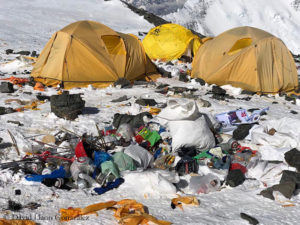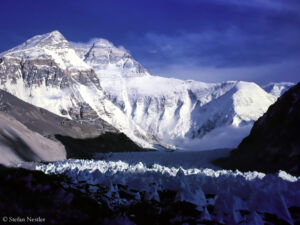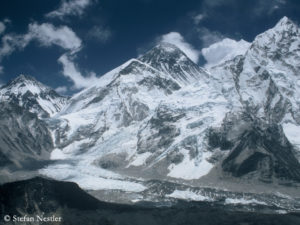The style debate in the mountaineering scene is gathering pace – not least because of the events on the eight-thousanders this year: 17 deaths on Mount Everest in the spring season; the record-breaking hunts by Norwegian Kristin Harila and...
The style debate in the mountaineering scene is gathering pace – not least because of the events on the eight-thousanders this year: 17 deaths on Mount Everest in the spring season; the record-breaking hunts by Norwegian Kristin Harila and Nepalese Tenjen Sherpa and others; the death of Pakistani high altitude porter Muhammad Hassan on K2; the four avalanche victims on Shishapangma, including Tenjen Sherpa.
In recent days, top mountaineers such as the Spaniards Kilian Jornet and the brothers Eneko and Iker Pou have commented on the question of whether everything that is possible should really be allowed in the mountains. I would particularly like to recommend Kilian’s essay to you. “Climbing style holds profound significance in the Himalayas, extending beyond personal preferences,” writes the 36-year-old. “As climbers, we are more than just athletes; we are stewards of these majestic mountains and paving the way for future generations. Every decision we make while climbing has consequences for the environment and others, shaping the future of climbing itself.”
I have tried to put together some conditions that I believe are necessary for a mountain project not only to be responsible, but also to advance alpinism. Hopefully this makes it clear that I am addressing climbers who are at the highest level of climbing. But there may also be some food for thought for the “normal” mountaineer.
1. Breaking new ground
If you are en route in the mountains on well-trodden paths, you may reach your personal limits and experience adventures, but you are not taking alpinism any further. The only exception is if you break new stylistic ground on a route that has already been climbed, for example by mastering it for the first time in alpine style or solo. So: look for challenging goals! The size of the challenge is more important than the height of the mountain.
2. In a small team
Roughly speaking: the smaller the team, the greater the achievement, not just the athletic one, but also the psychological one. A real solo – like Reinhold Messner’s on Everest in 1980, during the monsoon, when no one else was on the mountain – is more challenging than an ascent in pairs on the same route, where you can belay and help each other. The following also applies to small teams: the rope partners should be at least roughly equally capable. Only then can the tasks be shared equally – unlike in commercial groups, where the main burden lies with the mountain guides and Climbing Sherpas.
3. Without bottled oxygen
Around 100 years ago, mountaineers from British expeditions on the north side of Mount Everest proved that it is possible to reach altitudes above 8,000 meters without a breathing mask: in 1922, George Finch and Geoffrey Bruce reached an altitude of 8,320 meters, and in 1924 Edward Norton even made it to 8,572 meters in the couloir that was later named after him. And at the latest since Reinhold Messner and Peter Habeler’s first ascent of Everest without bottled oxygen in 1978, we know that the highest point in the world at 8,849 meters can also be reached without a breathing mask.
For pioneering alpine ascents, it must also apply that all (!) team members climb without supplemental oxygen. It makes a difference whether someone generally does without a breathing mask or includes it in his or her plans: for example, as a safety guarantee or by having Sherpas who use bottled oxygen break the trail or carry loads.
4. No infrastructure on the mountain
Real alpinists don’t need any infrastructure on the mountain. No helpers to break the trail – they do it themselves. No fixed ropes to pull themselves up. No fixed high camps, instead just a tent in your own rucksack. No helicopters to bring equipment or even people up the mountain. And should anyone be tempted to charter a helicopter to get to base camp – you can hike there. It may take longer, but it has two advantages: You get to experience the country and its people and acclimatize en passant, so to speak.
5. Leave nothing behind
Leave the mountain as you found it! Respect for nature and also for future generations of mountaineers dictates this. So: Pack up your tents and take them back down! Take off your ropes and take them back with you! Think sustainably when using safety equipment such as pitons, crampons, ice screws or snow anchors! Create as little waste as possible and take the unavoidable garbage back down the mountain – even excrement can be transported away in special bags!
6. Communicate honestly
There are many water level and success reports on social media in which mountaineers exaggerate, conceal important information or, in extreme cases, even lie. Good style also means sticking to the truth; not bending it but being accurate. For example, it makes a difference whether you climb without supporters or with one, two or more Sherpas; whether someone has climbed an eight-thousander without bottled oxygen on the normal route of commercial expeditions or on an unsecured route; whether you open a complete new route or a variant; …
Many top mountaineers are now doing what mountaineers used to in earlier times: they don’t announce their projects publicly, but only report on them afterwards. This takes the public pressure off them. It also gives them the peace and quiet they need to concentrate fully on their ambitious sporting goals. The world can wait – even if it is no longer used to it.
P.S.: For everyone, whether professional or amateur: humility is more important than ego. You can’t do it without respect for the mountain and for people and without a realistic assessment of your own abilities.
Der Beitrag Alpinism: Six commandments of good style erschien zuerst auf Adventure Mountain.






















